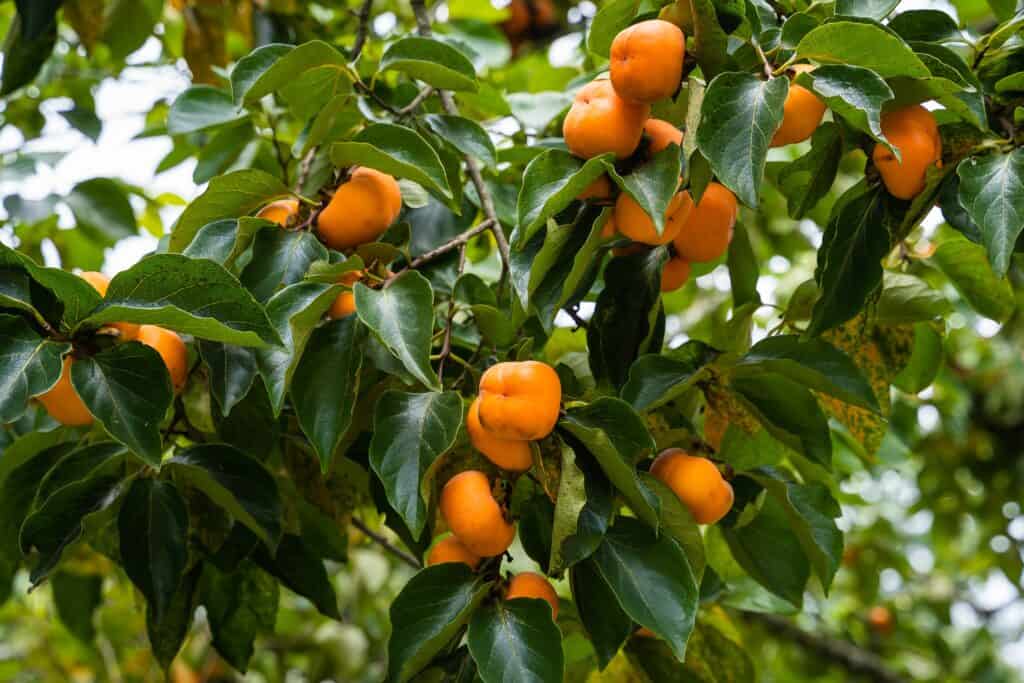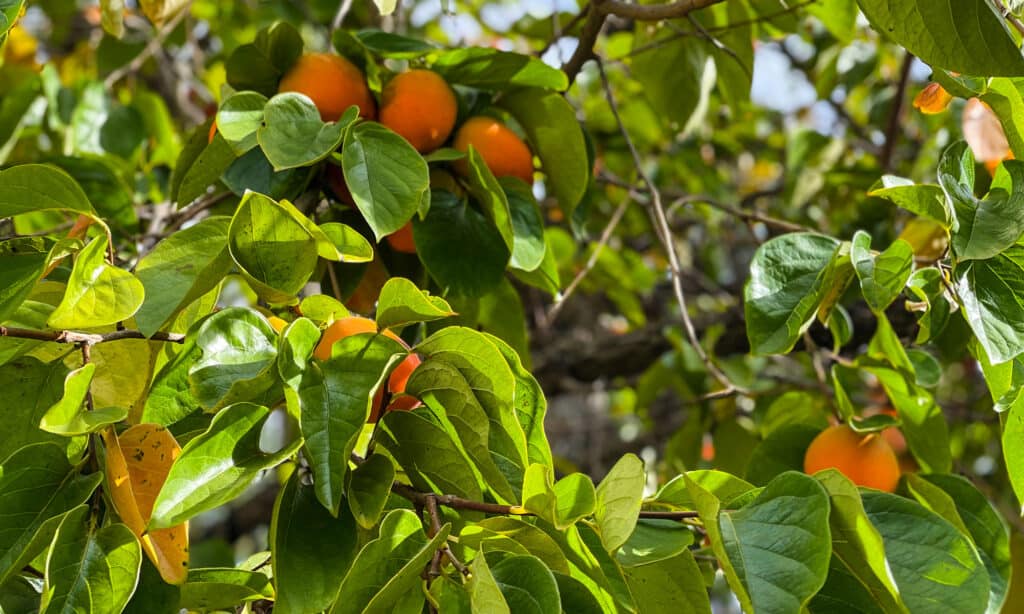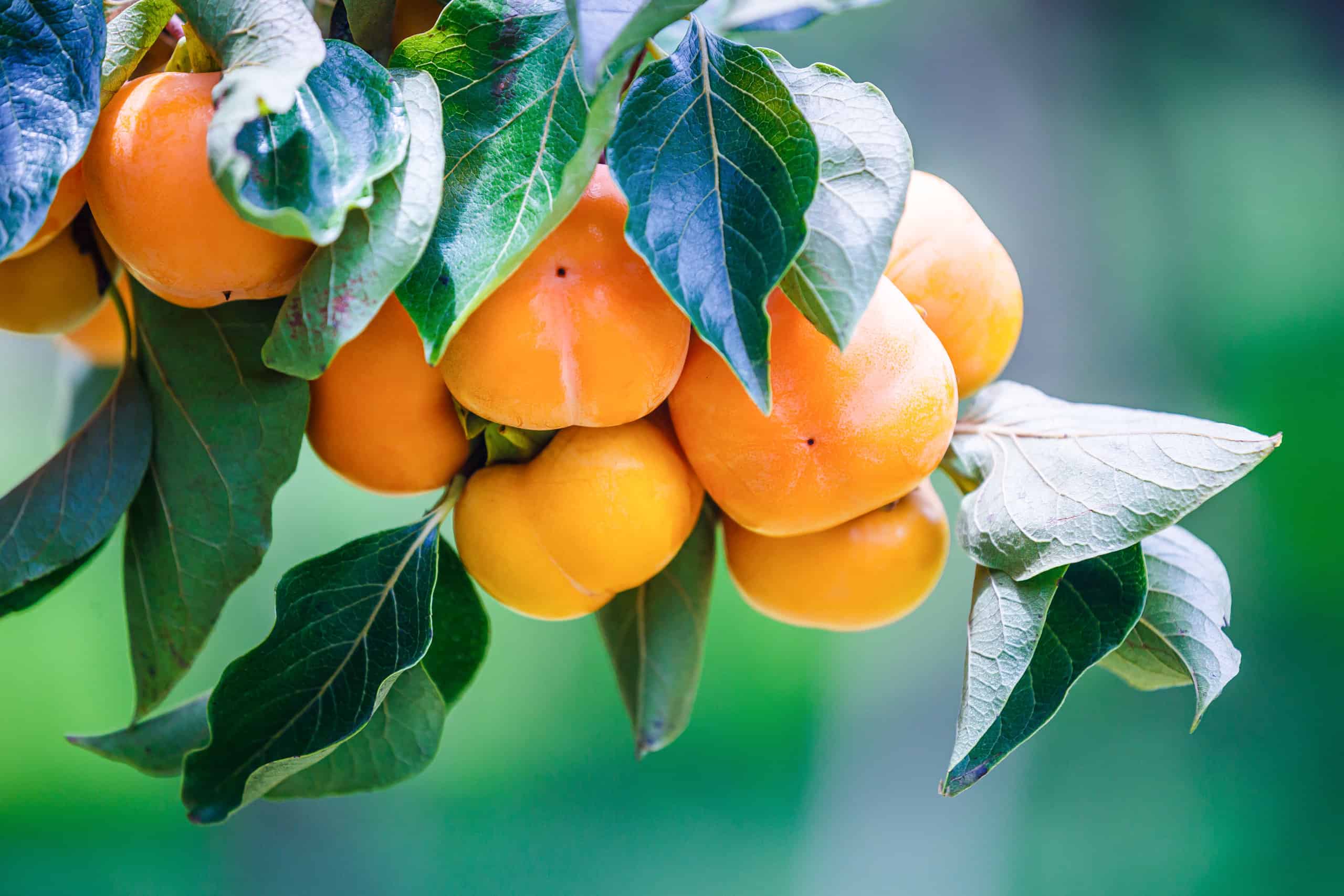Persimmon fans might be wondering when their favorite fruit is in season. Persimmons, with their rich, sweet flavor and tantalizing texture, come to their glorious zenith during the fall months. As the leaves begin to don their vibrant hues and a gentle chill graces the air, these gems of the orchard ripen to perfection. So, mark your calendars for autumn’s embrace if you wish to savor the finest harvest of these tasty fruits!
That being said, the exact months when they are ripe and where they can be found is another answer altogether. In this article, we shall uncover the secrets of these diverse locales and their role in nurturing these beloved fruits. There’s a lot to love about these delicious and unique fruits!
What is a Persimmon?
Persimmons are delicious and nutritious fruits that come in various shapes and sizes. These vibrant orange or reddish-orange fruits belong to the genus Diospyros and are native to Asia. They have been cultivated for centuries and are now enjoyed worldwide for their sweet flavor and numerous health benefits.
Appearance and Varieties
Persimmons are easily recognizable due to their unique appearance. They are typically round or oval-shaped and range in size from a small plum to a large tomato. The skin of these delicious fruits can be smooth or textured, depending on the variety. Some of the common varieties include Fuyu, Hachiya, and Sharon fruit.
- Fuyu – Fuyu persimmons are squat and resemble flattened tomatoes. They are non-astringent, meaning they can be eaten while still firm, like an apple. Their flavor is mildly sweet and often likened to a blend of mango and papaya.
- Hachiya – Hachiya persimmons are larger and have a heart-shaped appearance. Unlike Fuyu persimmons, the Hachiya variety is astringent when unripe, with a tannic taste that makes them unpleasant to eat. However, once fully ripe, they become soft and sweet, with a rich, honey-like flavor.
- Sharon Fruit – Sharon fruit, also known as the “Israeli persimmon,” is a hybrid variety that combines the best features of Fuyu and Hachiya. They are sweet, non-astringent, and have a slightly elongated shape.
Flavor and Culinary Uses
Persimmons are known for their delectable flavor, which varies depending on the ripeness and type. Ripe Fuyu persimmons are crunchy and refreshing, perfect for eating fresh or sliced in salads. On the other hand, ripe Hachiya persimmons are soft and pulpy, making them ideal for purees, jams, and baked goods. Sharon fruit falls in between the two, suitable for both fresh consumption and cooking.
One of the simplest and most enjoyable ways to enjoy these fruits is by eating them fresh. Simply wash the fruit, remove the stem, and bite into the luscious flesh. For the Fuyu variety, you can even slice them and add them to fruit salads for a burst of sweetness.
Ripe Hachiya persimmons are often used in baking, adding a natural sweetness to cakes, muffins, and cookies. Their smooth texture makes them a great addition to smoothies and ice creams as well. Sharon fruit is versatile and can be used in both raw and cooked forms, making it a popular choice among cooks.
Nutritional Benefits
Beyond their delightful taste, persimmons offer a range of health benefits. They are rich in essential nutrients, making them a valuable addition to any diet.
- Vitamins and Minerals – Persimmons are an excellent source of vitamin A, vitamin C, and potassium. Vitamin A supports vision and immune health, while vitamin C aids in collagen formation and boosts the immune system. Potassium helps regulate blood pressure and supports heart health.
- Dietary Fiber – These fruits are high in dietary fiber, promoting healthy digestion and preventing constipation. The fiber content also aids in maintaining stable blood sugar levels.
- Antioxidants – These fruits contain antioxidants like beta-carotene and lycopene, which help neutralize harmful free radicals in the body, reducing the risk of chronic diseases.
Persimmons are delightful fruit that comes in various types, each offering a unique taste and culinary applications. Whether enjoyed fresh, baked into treats, or added to savory dishes, they bring a burst of flavor and numerous health benefits to the table.

Persimmons that have been pitted are also safe for dogs to eat.
©Vadzim Mashkou/Shutterstock.com
Where Do Persimmons Grow?
Persimmons, with their tantalizing flavor and vibrant appearance, are cultivated in various regions around the world. However, these delightful fruits have specific environmental requirements that influence their growth and thriving.
Geographic Distribution
Persimmons have their origins in Asia, where they are native to China, Japan, and Korea. These regions have been cultivating and enjoying these fruits for centuries, contributing to the fruit’s rich history and cultural significance.
Over time, persimmons have spread to different parts of the world due to trade and exploration. Today, they are widely grown and enjoyed in countries such as the United States, Brazil, Spain, Italy, Turkey, and Israel, among others.
Climatic Requirements
Persimmons have specific climatic requirements to thrive and produce bountiful fruits. To start, these fruit trees prefer a temperate climate, with average temperatures ranging between 55 to 86 degrees F. While they can tolerate occasional frost during the dormant winter period, prolonged exposure to freezing temperatures can damage the fruit and affect the tree’s health.
These fruit-bearing trees also require ample sunlight to flourish. They do best in areas with full sun exposure, as it aids in the development of flavorful and sweet fruits.
Persimmons appreciate well-distributed rainfall during their growing season. However, excessive water can lead to root rot and other issues. In regions with insufficient rainfall, supplemental irrigation is essential to ensure proper growth and fruit development.
Soil Conditions
Persimmons are not overly demanding when it comes to soil, but certain characteristics contribute to their successful cultivation. Good drainage is crucial for persimmons, as they do not tolerate waterlogged soil. Sandy loam and loamy soils are ideal, allowing excess water to drain away from the roots. Persimmons generally prefer slightly acidic to neutral soil with a pH range of 6.0 to 7.5. This ensures proper nutrient uptake and overall tree health.
Growing Regions
As the birthplace of persimmons, Asian countries like China, Japan, and Korea remain major producers of these fruits. In these regions, persimmons are deeply ingrained in traditional cuisine and culture.
In the United States, persimmons are grown in several states, with California being a significant producer. The warm and sunny climate of California provides an ideal environment for successful cultivation.
European countries like Spain and Italy are renowned for producing high-quality persimmons. These countries boast suitable climate and soil conditions, contributing to the fruit’s success.
Persimmons are delightful fruits that have found their way into various regions around the globe. While they originate from Asia, they have adapted to different climates and are now cultivated in numerous countries. With their preference for temperate climates, well-draining soil, and ample sunlight, persimmon trees can thrive and produce delectable fruits that are enjoyed by people worldwide.

Persimmon trees can grow in a wide range of places around the world.
©Supermop/Shutterstock.com
When are Persimmons in Peak Season?
Persimmons, like many other fruits, have peak seasons during which they are most tasty and abundant. There is a specific best time of year to enjoy the sweet, juicy persimmon.
Seasonal Variations
Different types of persimmons have different prime harvest times. Depending on the variety of persimmon you have, you may want to wait until a certain time of year to eat them. Some persimmons, like the Fuyu, are at their best in the fall, while others, like the Hachiya, are at their prime in the late fall or early winter.
Peak persimmon season also differs by geography, as harvest times shift depending on latitude. The date of the harvest varies from region to region because of differences in climate and local growth circumstances.
Fuyu Persimmons
Fuyu persimmons, which are sweet and juicy but not astringent, are ready to be picked in the fall. This time of year often falls anywhere from September through November. During this time, Fuyu persimmons develop their characteristic bright orange or crimson color, signaling that they are at peak ripeness and ready to be eaten.
When ripe, Fuyu persimmons can’t be topped as a delicious snack. Their freshness, crunchiness, and mild sweetness make them a favorite. As they ripen, they become more juicy and sweet, making them excellent for nibbling or spicing up fruit salads.
Hachiya Persimmons
Hachiya persimmons have a later peak season than Fuyu, occurring in late autumn and early winter. Because they take longer to ripen, the harvest season is later in the year. Hachiya persimmons can be harvested from late fall until early winter, often between November and December.
Hachiya persimmons, in contrast to Fuyu persimmons, which can be consumed when still firm, require full ripening before being eaten. Due to their high tannic content, they can have a bitter, disagreeable flavor if consumed too soon. When ripe, they have a rich, honey-like flavor and turn mushy and jelly-like.
When fully ripe, Hachiya persimmons are a terrific addition to many dishes. They can be pureed and used as a sweetener in baked goods such as cakes, cookies, and pies. The mild flavor and tender flesh also make them perfect for use in sweets and puddings.
Sharon Fruit
Sharon fruit has a longer harvest window than other varieties since it shares the non-astringent qualities of Fuyu with that fruit but ripens at a later time. Like Hachiya persimmons, the Sharon fruit is at its peak from late fall to early winter.
Sharon fruit is a versatile option for individuals who want to enjoy persimmons over a longer length of time due to its extended harvest period. They are delicious when eaten fresh, but also have a lot of potential in the kitchen.

Persimmon fruits, in general, can be harvested in fall through very early winter.
©iStock.com/Huanyu Yao
USDA Hardiness Zones That are Unsuitable for Persimmons
Persimmons can thrive in a range of USDA hardiness zones, but their success varies depending on the variety. Generally, persimmons can grow in USDA hardiness zones seven to 11, covering a wide span of climates. Fuyu persimmons, known for their versatility and mild flavor, can tolerate colder temperatures and are suitable for zones seven to 11. On the other hand, Hachiya persimmons, with their astringent taste, prefer warmer climates and are best suited for zones eight to 11.
In zones seven and eight, where winter temperatures can dip below freezing, planting persimmons in a sheltered spot or using protective measures during extreme cold spells can enhance their chances of survival. For zones nine to 11, persimmon trees thrive with less risk of frost damage and can enjoy more extended growing seasons.
However, in regions with harsh winters like USDA hardiness zones one to six, persimmons may struggle to survive due to the sustained cold temperatures. The risk of frost and freezing conditions can damage or kill the trees, making these zones unsuitable for persimmon cultivation. Prospective growers must check their specific hardiness zone before planting persimmons to ensure the best chance of success and a bountiful harvest of these delightful fruits.
Tips for Growing Your Persimmon Tree
If you have a passion for gardening and desire to savor the sweet, succulent flavors of fresh persimmons right from your backyard, growing your persimmon tree can be a rewarding journey. While it demands patience and care, the process is relatively straightforward, and the joy of harvesting your homegrown fruit is truly gratifying.
Selecting the Right Variety
Consider your climate and choose a persimmon variety that thrives in your region. Fuyu persimmons are ideal for temperate climates, while Hachiya and Sharon fruit varieties may suit areas with mild winters. Determine if the variety is self-pollinating or requires cross-pollination.
Choosing a Location
Find a spot in your garden that receives at least 6 to 8 hours of direct sunlight daily, as persimmon trees flourish in full sunlight. Consider planting near a windbreak or creating a barrier to protect young saplings from strong winds that could damage tender branches.
Preparing the Soil
Ensure the soil is well-draining to prevent waterlogged roots. Add organic matter like compost to improve drainage in heavy clay soils. Persimmons prefer slightly acidic to neutral soils with a pH range of 6.0 to 7.5; adjust the pH if necessary using appropriate amendments.
Planting the Sapling
Choose early spring or late fall, when the tree is dormant, to plant persimmon saplings. Dig a hole twice the size of the root ball, gently loosen the roots before planting, and ensure the sapling is planted at the same depth as in its nursery container.
Watering and Care
Water young persimmon trees regularly, keeping the soil consistently moist but not waterlogged, especially during the first year of growth. Apply organic mulch around the base of the tree to retain moisture and suppress weed growth, leaving a small gap around the trunk. In the spring, use a balanced fertilizer for fruit trees to promote healthy growth and fruit production.
Pruning and Training
Prune young trees to encourage a strong framework of branches and remove any damaged or crossing limbs. Decide on the desired shape for the tree and train the branches accordingly, such as central leader or open vase shapes.
Pollination and Fruit Development
If cross-pollination is needed, plant another compatible persimmon variety nearby to ensure a fruit set. Once the tree starts bearing fruit, thin the young fruit clusters to allow the remaining ones to develop fully and avoid overcrowding.
Harvesting
Be patient, as persimmons usually take a few years to bear significant fruit. Ripe persimmons should be firm but slightly soft to the touch, depending on the variety. Harvest them carefully to avoid bruising and enjoy the fruits of your labor.
Thank you for reading! Have some feedback for us? Contact the AZ Animals editorial team.








